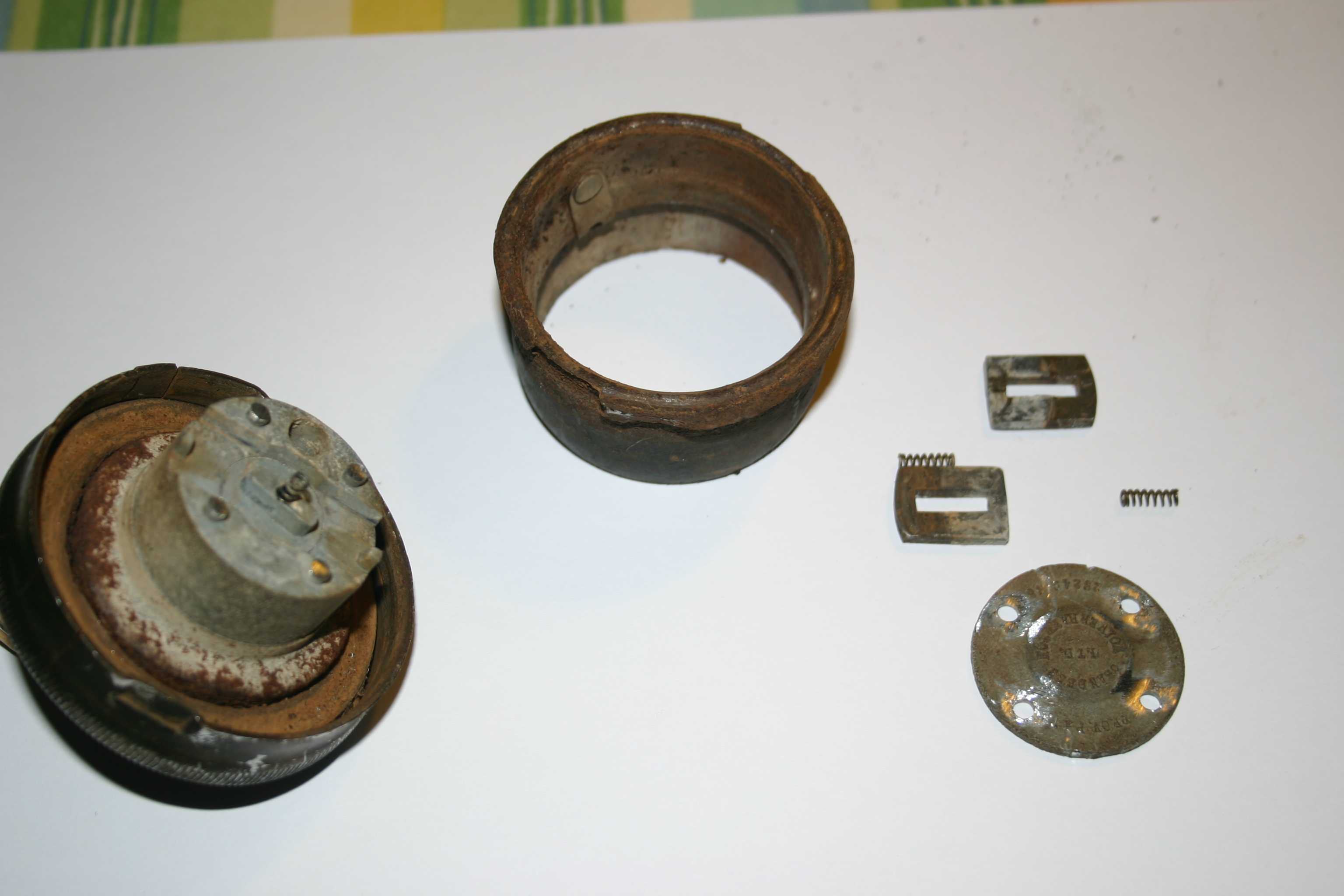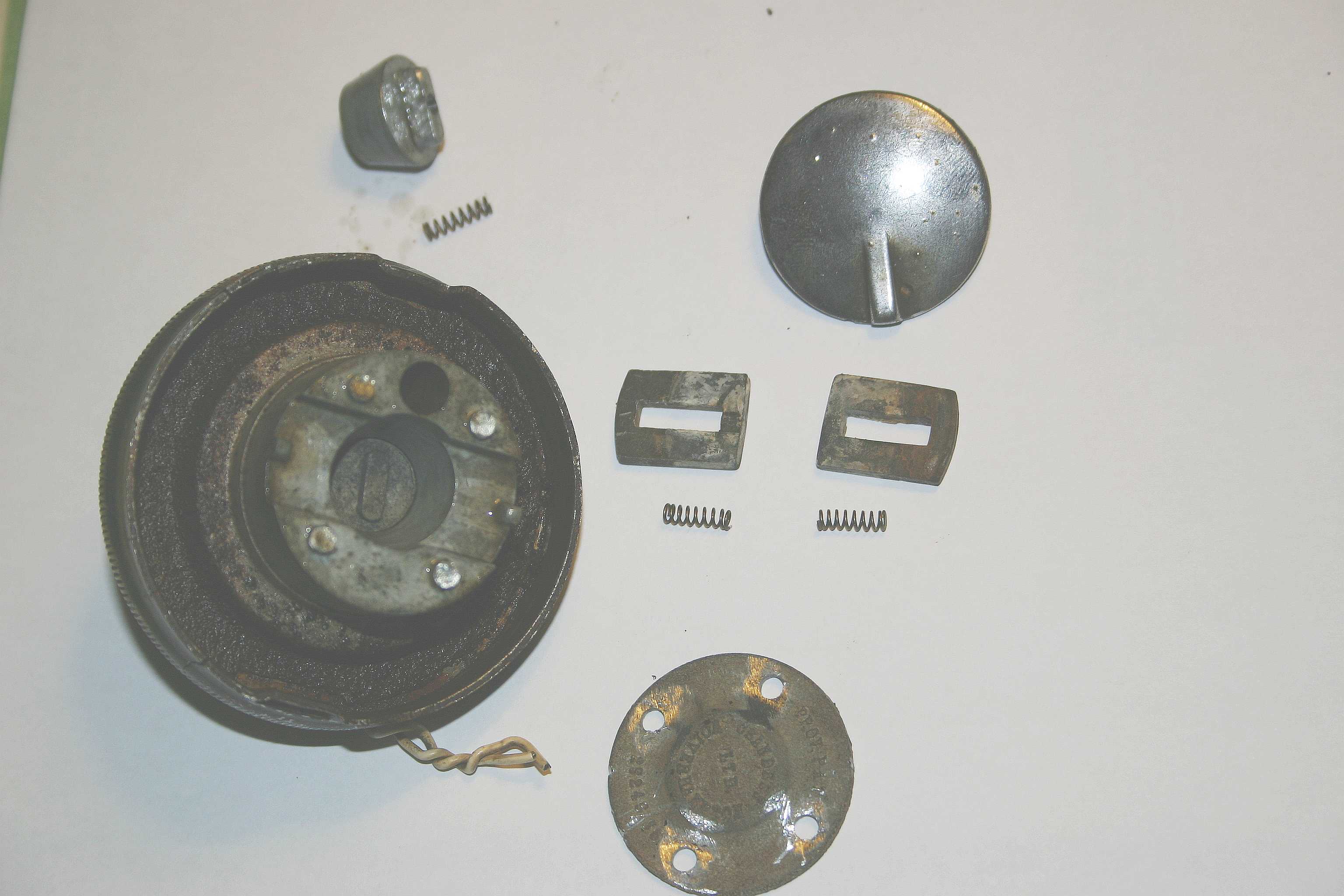K_Reparaties - K_Repairs ( 15.08.2010 )
Problem K: Lockable fuel cap "locked" added 15/08/2010
MK II Sabras have lockable fuel caps.They were made by CEANDESS Ltd Wolverhampton (#24245/55).
When Jacques bought his GT the car was already dismantled. The filler tube was in a box with the filler cap on it and a key in the slot.
But the key wouldn't turn and as the cap was in the "locked" position it couldn't be removed from the filler tube.
Remark that the filler tube has part # 5243 and the filler cap has #5976, so these parts were already in use by Reliant,
though they're not from the Regal.
The cylinder moved easily, but only over a very small angle in both directions. After several hours of lock picking I learned for sure that the key was
the correct one and that the turning of the cylinder wasn't blocked by the wafers but by something behind it, that should be rotated by the cylinder but was stuck.
So I sawed off the end of the filler tube, close to the rim where the filler cap sits. Then I drilled out the four aluminium rivets that hold the back cover of the filler cap.
The cap could now be freed from the filler tube as the two wafers jumped out. See pic:
The picture shows that a rectangular rim with rounded edges was pushing the two wafers in their outside (locking) position.
Took me again several days, and a lot of patience to get that thing loose:WD40, heating, WD40, tapping, spoke to the Lord quite frequently. See pic
It shows that the thing that shoved the wafers in their outside position was conical, sitting in a conical seat, and driven by same kind of rim on the rear
side of the cylinder.
Those cones, certainly in zamac, are bound to get stuck, the more as the cone is pushed into it's seat by a spring.
I cleaned and oiled everything, replaced the rivets by tiny screws, soldered the cut off part of the filler tube back on the other end
and Jacques had a working filler cap. This was done several years ago.
I write this because today the same conical thing got stuck (not the first time) in my Sabra: got it loose by blowing compressed air in the cap from the locking side.
I had first checked that.the wafers were free. The pressurised air must have pushed the conical thing up against the little spring thus freeing it.
This wouldn't have worked with Jacques' filler cap, that was stuck for over ten years, but mine had been open a fourthnight ago.
Think the fuel vapors wash the lubricants away. Anyway the filler cap is a "black box" - not to be opened - but if you know what's inside you can think about solutions.
Jef Neefs
Problem K: SU-Carburettors (added 14/01/2006)
There's nothing much that can go wrong with an SU and to deal with feeding an engine the right mixture they're a marvellous discovery..
Three normal maintenance checks:
Small possibility that the pressure from the fuel-pump is too high, read the manual to check the pressure.
like it when I can count the rpm's.
Last thing you can do is to put your ear
against the air-inlets (or use a water-tube as is indicated in the text).
Both carburettors should make the same "hissss", this you can
do at different rpms, if they're trimmed wrong there's an obvious difference.
To learn how to recognise the difference you can use the lifting pins to make
difference.
If at idle speed there's not too great a difference you can probably adjust the hisss by turning the throttle adjusting screws. If you can't get it right could mean the balance of the carburettors was set wrong, and if it had been right could indicate serious problems - wear at valves or pistons.
Problem K: SU-Carburettors (added 28/09/2006) Throttle retractor springs
While on the way to Goodwood early september 2006 when I lifted my right foot to slow down the pedal didn't follow anymore. One of the springs that should close the throttle when the pedal is not pushed, had broken. I was following André and we were both lucky that I didn't follow him too close. A nowadays car should have been towed home but I managed a quick repair and after the meeting and a lovely vacation in UK I went for a replacement. As allways I did lots of shops and bought some 25 different replacement springs that would all have worked but I had rather found some identical ones. At last found the closest fit with Hillaert (see adresses).
The springs on my car (don't know if they are
original) were made of a thread of 0.8mm thick, external diameter of the spring
7,45mm wide, length of the body of the spring (all windings next to another) was
56.5mm, and the hooks were adding +/- 5mm to the length of the spring. The ones
I have fitted now are made of RVS - "rust resistant steel". In
Belgium we call it INOX(idable).
Haven't driven the car since, but it looks nice (shiny). For about some 20€
Hillaert would remake any pair of springs of about that size.
Fitted the "Hillaert"-springs because they were closest (identical) to
the original. Perhaps RVS is harder and will brake sooner than 30years of
pushing the throttle.(Jef Neefs)
Mail of bel mij als je tips, hints of kennis op dit gebied hebt... 03/236.00.84


